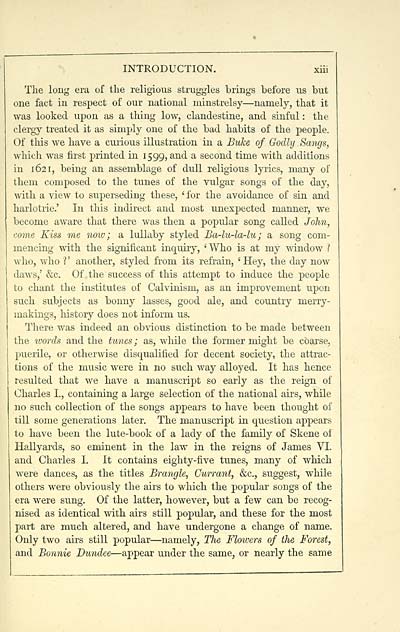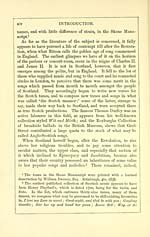Glen Collection of printed music > Printed text > Songs of Scotland prior to Burns
(17) Page xiii
Download files
Complete book:
Individual page:
Thumbnail gallery: Grid view | List view

INTRODUCTION. xiii
The long era of the religious struggles brings before us but
one fact in respect of our national minstrelsy — namely, that it
was looked upon as a thing low, clandestine, and sinful : the
clergy treated it as simply one of the bad habits of the people.
Of this we have a curious illustration in a Buhe of Godly Sang 's,
which was first printed in 1599, and a second time with additions
in 1 62 1, being an assemblage of dull religious lyrics, many of
them composed to the tunes of the vulgar songs of the day,
with a view to superseding these, ' for the avoidance of sin and
harlotrie.' In this indirect and most unexpected manner, we
become aware that there was then a popular song called John,
come Kiss me noio ; a lullaby styled Ba-lu-la-lu ; a song com-
mencing with the significant inquiry, 'Who is at my window ?
who, who 1 ' another, styled from its refrain, ' Hey, the day now
daws,' &c. Of the success of this attempt to induce the people
to chant the institutes of Calvinism, as an improvement upon
such subjects as bonny lasses, good ale, and country merry-
makings, history does not inform us.
There was indeed an obvious distinction to be made between
the words and the tunes ; as, while the former might be coarse,
puerile, or otherwise disqualified for decent society, the attrac-
tions of the music were in no such way alloyed. It has hence
resulted that we have a manuscript so early as the reign of
Charles I., containing a large selection of the national airs, while
no such collection of the songs appears to have been thought of
till some generations later. The manuscript in question appears
to have been the lute-book of a lady of the family of Skene of
Hallyards, so eminent in the law in the reigns of James VI.
and Charles I. It contains eighty-five tunes, many of which
were dances, as the titles Brangle, Currant, &c, suggest, while
others were obviously the airs to which the popular songs of the
era were sung. Of the latter, however, but a few can be recog-
nised as identical with airs still popular, and these for the most
part are much altered, and have undergone a change of name.
Only two airs still popular — namely, The Flowers of the Forest,
and Bonnie Dundee — appear under the same, or nearly the same
The long era of the religious struggles brings before us but
one fact in respect of our national minstrelsy — namely, that it
was looked upon as a thing low, clandestine, and sinful : the
clergy treated it as simply one of the bad habits of the people.
Of this we have a curious illustration in a Buhe of Godly Sang 's,
which was first printed in 1599, and a second time with additions
in 1 62 1, being an assemblage of dull religious lyrics, many of
them composed to the tunes of the vulgar songs of the day,
with a view to superseding these, ' for the avoidance of sin and
harlotrie.' In this indirect and most unexpected manner, we
become aware that there was then a popular song called John,
come Kiss me noio ; a lullaby styled Ba-lu-la-lu ; a song com-
mencing with the significant inquiry, 'Who is at my window ?
who, who 1 ' another, styled from its refrain, ' Hey, the day now
daws,' &c. Of the success of this attempt to induce the people
to chant the institutes of Calvinism, as an improvement upon
such subjects as bonny lasses, good ale, and country merry-
makings, history does not inform us.
There was indeed an obvious distinction to be made between
the words and the tunes ; as, while the former might be coarse,
puerile, or otherwise disqualified for decent society, the attrac-
tions of the music were in no such way alloyed. It has hence
resulted that we have a manuscript so early as the reign of
Charles I., containing a large selection of the national airs, while
no such collection of the songs appears to have been thought of
till some generations later. The manuscript in question appears
to have been the lute-book of a lady of the family of Skene of
Hallyards, so eminent in the law in the reigns of James VI.
and Charles I. It contains eighty-five tunes, many of which
were dances, as the titles Brangle, Currant, &c, suggest, while
others were obviously the airs to which the popular songs of the
era were sung. Of the latter, however, but a few can be recog-
nised as identical with airs still popular, and these for the most
part are much altered, and have undergone a change of name.
Only two airs still popular — namely, The Flowers of the Forest,
and Bonnie Dundee — appear under the same, or nearly the same
Set display mode to: Large image | Transcription
Images and transcriptions on this page, including medium image downloads, may be used under the Creative Commons Attribution 4.0 International Licence unless otherwise stated. ![]()
| Special collections of printed music > Glen Collection of printed music > Printed text > Songs of Scotland prior to Burns > (17) Page xiii |
|---|
| Permanent URL | https://digital.nls.uk/90575942 |
|---|
| Description | Scottish songs and music of the 18th and early 19th centuries, including music for the Highland bagpipe. These are selected items from the collection of John Glen (1833 to 1904). Also includes a few manuscripts, some treatises, and other books on the subject. |
|---|
| Description | The Glen Collection and the Inglis Collection represent mainly 18th and 19th century Scottish music, including Scottish songs. The collections of Berlioz and Verdi collected by bibliographer Cecil Hopkinson contain contemporary and later editions of the works of the two composers Berlioz and Verdi. |
|---|

